Mastering Kitchen Staging for an Open House: Tips for Real Estate Success
How Highlight Your Home’s Best Feature
For real estate agents and sellers with homes ready to list, decorating and decluttering are crucial steps to prepare a property. Staging helps prospective homeowners see the potential in a home. With the right furniture and décor in place, it’s easier for them to imagine living there—and that often translates into sales.
The numbers don’t lie: 20% of buyer agents saw price increases of 1-5% for staged homes compared to unstaged properties.
Staging a property’s kitchen is particularly essential. As arguably one of the most important rooms in a house, it’s crucial to get it right. Many sellers and agents already use intentional design touches in the kitchen since it’s the second most common room to be staged at 81%.
But when it comes to staging ideas for kitchens, where do you start? Below, you’ll learn why kitchen staging is necessary, plus some home staging tips to give your space a facelift.
The importance of kitchen staging in real estate
The kitchen holds a special place in the hearts of many homebuyers. We prep and cook food there, and we often gather and break bread with our loved ones there. So, it’s no surprise the kitchen is where homeowners spend much of their time—an estimated 400 hours annually.
So, the right staging ideas for a kitchen can get the attention of buyers and even boost your bottom line for a sale.
Good first impressions
Whether buyers are considering a property via an online listing or attending a showing, real estate agents and sellers only have one chance to make a first impression. And staging can make all the difference—after all, 58% of buyers’ agents said that staging affected buyers’ opinions of properties most of the time.
That’s why it’s crucial to stage your property, and particularly your kitchen, in an appealing way. Tasteful staging can influence prospective buyers and leave them with a positive impression of your property.
Helps home buyers visualize possibilities
The staging process converts your home into a clean slate. When you declutter, rearrange furniture, and pare back design elements in a kitchen, it’s easier for potential buyers to imagine using the space themselves.
The majority (81%) of buyers’ agents agreed, saying staging allowed buyers to envision the space as their future home. And when buyers mentally move in, it paves the way for them to make an offer and physically move in.
Gives the property a competitive advantage
Getting your property to stand out from dozens of others for sale is an ongoing challenge. With so many homes to sift through, it’s tough to differentiate your property from others. But that’s where staging can help.
As aforementioned, when buyers can visualize a property being their future home, they’re more likely to take the next steps. That’s why they’re willing to see properties in person that resonate with them online.
Research showed that buyers were 40% more likely to do a walkthrough of homes they viewed online, and 34% of buyers’ agents said staging with tasteful décor affected the home value.
Higher perceived value
While staging does take additional time, money, and effort for realtors and home sellers, the investment pays off. When buyers see a well-staged home, they often believe it’s worth more—and that translates to a higher selling price.
As a matter of fact, spending 1.3% of the sale price on staging leads to an average return of 7.1% over-listing. The same research showed that professionally staged properties sold for $40,000 over the list price on average.
Based on that kind of ROI, this higher perceived value makes staging well worth the investment.
Quicker sales
Not only does staging impact the sales price of a property, but it can also lead to faster sales. Almost half (48%) of sellers’ agents noted home staging decreased a property’s time on the market.
Another study revealed just how disparate the selling timelines can be between staged and unstaged homes. According to the Real Estate Staging Association, unstaged homes averaged 184 days on the market before selling. Compare that to staged homes selling after an average of only 23 days.
4 kitchen staging ideas to increase curb appeal
Not sure where to start with a mini makeover for your kitchen? These kitchen staging ideas will help you spruce up the room before listing it on the market.
1. Let there be light
Well-lit, airy kitchens are in. To cater to this trend, maximize the natural and artificial light in your kitchen.
Giant windows are obviously a huge plus, but you can create that light and airy feel by changing out light fixtures, a fresh coat of paint on the walls in light colors, and adding reflective matte surfaces (think a matte white kitchen island).
You can also paint your kitchen cabinets a lighter hue to brighten up the space.
The staged kitchen below features a large white island with matching walls and cabinetry, light wood floors, plus multiple large chandeliers.
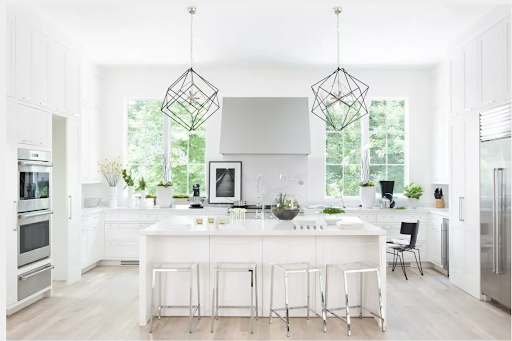
Bright, airy kitchen from designer Elizabeth L. of décorilla
2. Clean, organize, and clear the clutter
Even if you don’t explore any other staging ideas for your kitchen, take the chance to declutter and do a deep clean. Regardless of any prospective buyers’ preferred décor or taste, they all appreciate a fresh and tidy space.
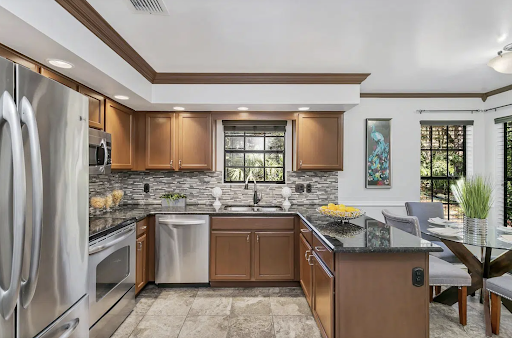
Source: MHM Professional Staging
So, DIY it with some elbow grease (or hire a cleaning service). Focus on tasks like:
Clearing off kitchen countertops
Wiping down the front of appliances, cabinets, and all surfaces to remove stains, grime, and smudges
Scrubbing grout to remove mildew
Degreasing vent and exhaust hood
Sweeping and mopping floors
Removing personal items (like family photos, tchotchkes and a collection of fridge magnets)
Installing drawer dividers to add order
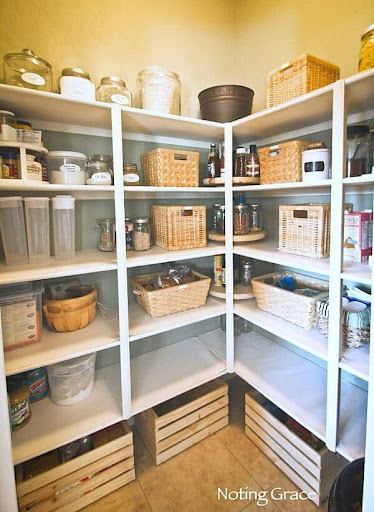
3. Add pops of color
While it’s wise to stick to an overall clean and neutral kitchen look, you can add personality via colorful décor pieces or a bold piece of art.
Interior designer and stager Janet Lorusso told Apartment Therapy sellers can pull inspiration from other parts of the property.
“If you have a neutral kitchen, pick an accent color from one of the adjacent rooms and use it for kitchen towels, pot holders, accessories, or artfully displayed cookware on a stovetop.”
That could take shape as a patterned backsplash and vase, like the example below:
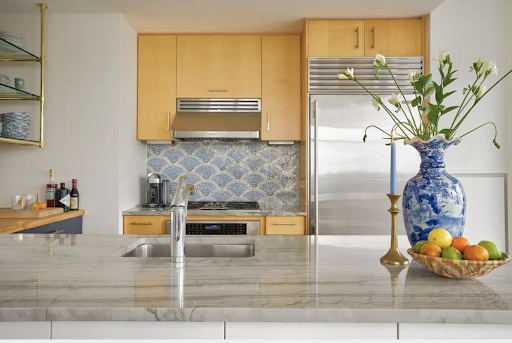
Source: Decorilla designer Samantha S.
You can also add pops of color via flowers, plants, or fresh fruit:
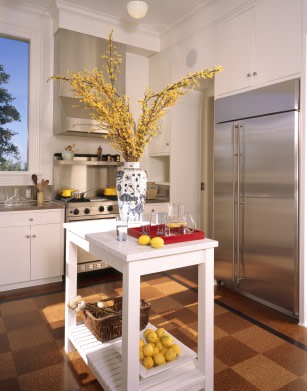
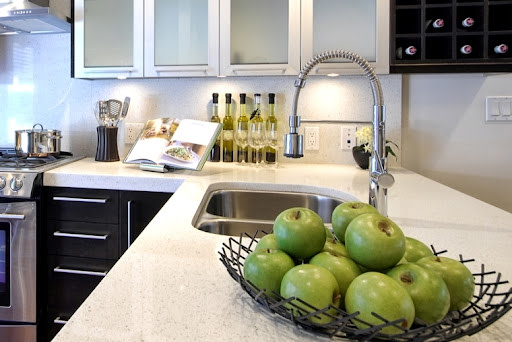
4. Warm up a kitchen with texture and homey touches
Your kitchen staging may be clean with neutral tones, but that doesn’t mean it shouldn’t be homey. Create a lived-in look by adding textures like tea towels, pot holders, and rugs.
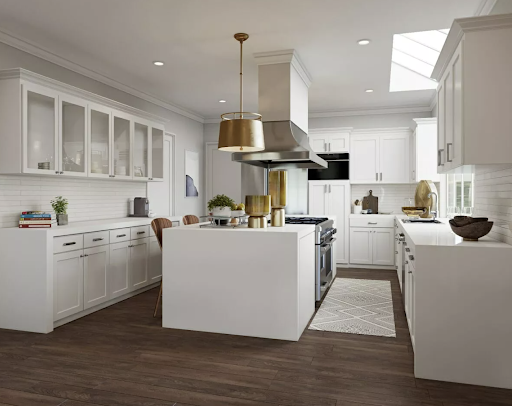
Source: Decorilla designer Jessica D.
Or set up a coffee station to add warmth to your space. Include a coffee maker or espresso machine, mugs, assorted sweeteners, and some fresh pastries.
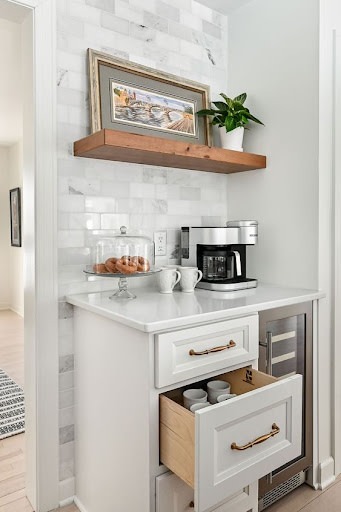
Source: Kowalske Kitchen and Bath
How can AI help kitchen staging?
Virtual staging has become a crucial tool for agents and home sellers—and a must-have for prospective buyers as well. Almost half (42%) of buyers’ agents said it was much more or more important to clients to have virtual tours available for listings. Artificial intelligence (AI), paired with the power of virtual tours and staging, will help cut your costs and take your listings to the next level. Here’s how.
Photorealistic 3D models
Matterport uses AI to make it simple for anyone to create a 3D model of a property. Whether you use a smartphone, or Matterport’s Pro series cameras, Matterport automatically analyzes the dimensions, permanent fixtures, and materials that comprise a space for you, quickly creating an accurate virtual version. That way, potential buyers can tour the property even if they never step foot inside.
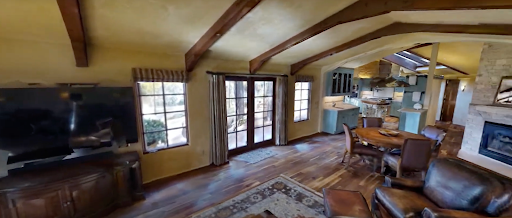
Even if the space is unfurnished, AI can help you add in furniture, décor, and other design elements that allow the property to look fully staged. AI is more cost-effective and flexible than other virtual staging methods because it allows you to change the look of a space quickly and with minimal effort. AI also eliminates the guesswork involved in virtual staging because it can automatically identify areas where furniture fits best, as well as what types of pieces work within a specific room. This feature is especially useful when trying to stage multiple properties at once.
Personalized design options
With all the details of your property (including your kitchen) captured digitally, it’s easy to switch out different kitchen design elements to help buyers visualize different kitchen design preferences in your space.
For example: In your virtually staged kitchen, you can add a skylight over the center island to see how it looks. Rearrange furniture, try out different paint colors, or even reconfigure the whole space. And because it’s all digital, you can hit undo and start from scratch.
Space optimization using algorithms
AI is certainly available for staging today and widely used, but it’s the potential that is most exciting. Soon enough, AI will be able to suggest ways to save space in your kitchen, including options to configure your kitchen more efficiently. For example, AI could suggest you move your hanging pot rack closer to your oven rather than on a far wall. Or to rearrange the appliances and cabinets to maximize your prep space.
Cuts costs
The costs of physically staging a kitchen—let alone an entire property—add up fast. One 2021 report showed the average cost to stage a vacant house was $2,900-$5,250. Fortunately, AI can significantly reduce this expense.
Rather than paying a staging service or setting up a space yourself, you can lean on the power of virtual staging and AI to demonstrate the potential of a property. Opting for virtual home staging rather than physical staging can slash those costs by upwards of 97%.
Entice buyers with personalized AI virtual staging according to their preferences
It’s hard to argue with all the aforementioned advantages—which is why Matterport is adding AI enhancements to digital twins to help agents and sellers virtually stage a buyer’s “perfect kitchen.”
As the industry's leading digital twin platform for the world’s largest asset class - real estate - Matterport continues to deliver significant enhancements in AI-powered automation and insights so homebuyers can quickly get new insight into a property’s potential, eliminating their reliance on time-consuming site visits and the extra back-and-forth between buying and selling agents.
Auto-generated measurements, easy-to-read property layouts, and automated property reports all make it simpler than ever for home buyers to evaluate, visualize, and select the best house to call home. With a few clicks, prospective buyers can see the length of walls, doors, and check room dimensions - even the kitchen pantry. The best part? Now each digital twin will include many of the most commonly sought dimensions, automatically!
All this data makes it easier for agents and home sellers to quickly spin up new digital twins based on buyer preferences to help drive home the property’s potential. Have a prospective buyer who wants to see how a new 10-foot island would look in your kitchen? With the next-generation digital twins, Matterport can help create home buyers or owners plan their ideal kitchen—complete with an oversized island.
And that’s only one example of how Matterport’s game-changing AI-enabled tools add a new level of customization to virtual staging. When you can stage based on buyer tastes, the possibilities are endless.
